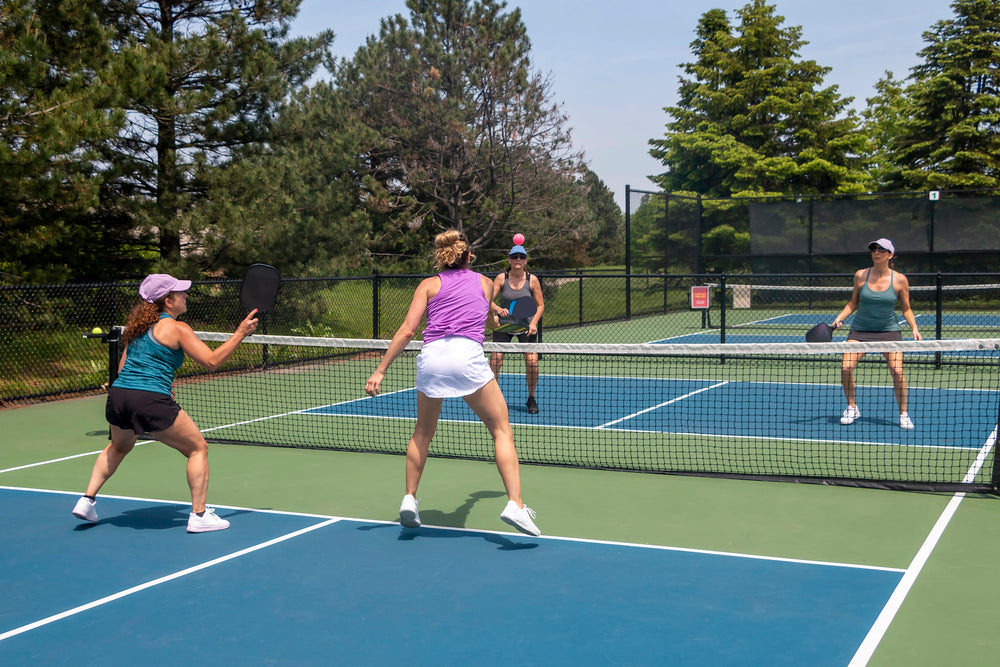
Padel vs. Pickleball – What’s the Difference?
Share
Two sports. Two surges in popularity. But only one will steal your heart—or maybe both will. Padel and pickleball are among the fastest-growing sports in North America, each offering fun, fitness, and a friendly learning curve. But how do they really compare? Whether you're choosing a new hobby or trying to convince a friend to switch sides, this breakdown will help you understand the differences, similarities, and what makes each sport unique.
What is Padel? What is Pickleball?
Padel is a racquet sport that originated in Mexico and took off in Spain and Latin America before gaining traction in the U.S. It’s played in doubles on a walled court with a perforated paddle and tennis-like ball.
Pickleball, born in Washington State in the 1960s, combines elements of tennis, badminton, and ping pong. It's played on a smaller open court with a plastic wiffle ball and solid paddle.
Both games are booming in popularity, but they appeal to different audiences—and play very differently.
Court & Dimensions
| Feature | Padel | Pickleball |
|---|---|---|
| Court Size | 20x10 meters (65x33 ft) | 13.4x6.1 meters (44x20 ft) |
| Enclosure | Enclosed with glass and mesh | Open court with lines |
| Net Height | 88 cm (center) | 86 cm (center) |
| Players | Almost always doubles | Singles or doubles |
Padel courts feature walls that are part of the game—like squash—whereas pickleball is entirely open.
Equipment
- Padel Paddle: Solid, foam-filled carbon or fiberglass face with holes.
- Pickleball Paddle: Lightweight composite or polymer, flat with no holes.
- Padel Ball: Looks like a tennis ball but has slightly lower pressure.
- Pickleball Ball: A hard plastic ball with holes (similar to a wiffle ball).
Padel gear tends to be more technical and performance-based, while pickleball gear is generally lighter and more accessible for casual play.
Gameplay Style
Padel
- Fast-paced rallies using walls to continue points.
- Underhand serve with bounce.
- Emphasis on strategy, teamwork, and positioning.
- Often longer rallies due to use of back glass.
Pickleball
- Quick reflex volleys dominate the game.
- Serve is underhand but without bounce.
- The "kitchen" (non-volley zone) adds strategic complexity.
- Shorter points, faster tempo.
Scoring Systems
- Padel: Traditional tennis scoring (15, 30, 40, game). Matches are best-of-three sets.
- Pickleball: Unique scoring to 11 points (win by 2), and only the serving team can score.
Accessibility & Learning Curve
Pickleball is known for being one of the easiest sports to pick up. Because of its smaller court, lighter ball, and lower-impact nature, it's hugely popular among older adults and community centers.
Padel, while still beginner-friendly, involves more complex movement and strategy due to the glass walls and longer rallies. It’s often embraced by former tennis players, athletes, and younger urban professionals.
Injuries and Physical Impact
-
Pickleball: Lower physical intensity, but repetitive motion injuries and footwork issues (especially among older adults) are common.
-
Padel: Slightly higher impact, but more diverse movement. Courts are softer on the joints than asphalt tennis courts.
Community and Culture
-
Pickleball: Often community-driven, with a casual social vibe.
-
Padel: Increasingly lifestyle-focused—boutique padel clubs feature lounges, music, and social events.
Growth Trends
-
According to the Sports & Fitness Industry Association (SFIA), pickleball grew by 159% between 2020 and 2023, reaching over 8.9 million players in the U.S.
-
Padel is catching up. With over 250 courts now in the U.S., it’s growing rapidly in markets like Miami, New York, Los Angeles, and Austin. Celebrity investors such as David Beckham and LeBron James have added to the buzz.
Padel is especially booming in Canada’s urban hubs. Organizations like Padel Canada are driving court development and competitive growth.
Which Sport Should You Try?
| Want This? | Try Padel | Try Pickleball |
|---|---|---|
| Longer rallies & strategy | ✔️ | |
| Lower barrier to entry | ✔️ | |
| Social doubles experience | ✔️ | ✔️ |
| Competitive global scene | ✔️ | |
| Relaxed pace and casual fun | ✔️ |
There’s no right or wrong choice (we prefer padel) — it depends on your goals and personality. If you love intensity, longer rallies, and dynamic movement, padel might be your next obsession. If you want low-impact fun and easy accessibility, pickleball is perfect.
Want to gear up for padel? Check out our handcrafted rackets at ClimaPadel.com, made in Spain and designed for both beginners and intermediate players.
